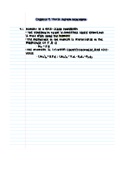Resultants - Study guides, Class notes & Summaries
Looking for the best study guides, study notes and summaries about Resultants? On this page you'll find 20 study documents about Resultants.
All 20 results
Sort by
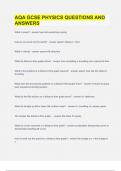
-
AQA GCSE PHYSICS QUESTIONS AND ANSWERS.
- Exam (elaborations) • 28 pages • 2023
- Available in package deal
-
- $16.49
- + learn more
What is speed? how fast something is going How do you work out the speed? speed= distance ÷ time What is velocity speed with direction What do distance-time graphs show? how something is travelling over a period of time What is the gradient of a distance-time graph equal to? speed- how fast the object is travelling What does the downwards gradient on a distance-time graph show? it means its going back towards its starting location What do the flat...
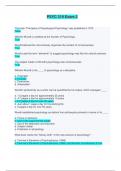
-
PSYC 319 Exam 2 | Questions with complete solutions
- Exam (elaborations) • 27 pages • 2024
-
- $22.49
- + learn more
PSYC 319 Exam 2 | Questions with complete solutions The book "Principles of Physiological Psychology" was published in 1973 False Wilhelm Wundt is credited as the founder of Psychology. True Wundt believed the mind actively organizes the content of consciousness True Wundt used the term "elements" to suggest psychology was like the natural sciences True The subject matter of Wundt's psychology was consciousness True Wilhelm Wundt is the ____ of psychology as a discipline. a. Originator b....
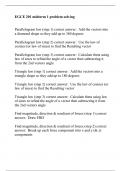
-
EGCE 201 midterm 1 problem solving
- Exam (elaborations) • 5 pages • 2023
-
- $10.49
- + learn more
Parallelogram law (step 1) correct answer: Add the vectors into a diamond shape so they add up to 360 degrees Parallelogram law (step 2) correct answer: Use the law of cosines (or law of sines) to find the Resulting vector Parallelogram law (step 3) correct answer: Calculate theta using law of sines to refind the angle of a vector then subtracting it from the 2nd vectors angle Triangle law (step 1) correct answer: Add the vectors into a triangle shape so they add up to 180 degrees ...
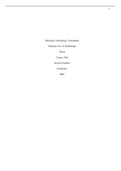
-
BUSINESS ANALYSIS AND SYSTEM RECOMMENDATION: Maryland Technology Consultants (MTC) is a successful Information Technology consulting firm that utilizes proven IT and management methodologies to achieve measurable results for its customers. Its customer b
- Case • 12 pages • 2023
-
- $4.39
- + learn more
Maryland Technology Consultants: aryland Technology Consultants (MTC) is a successful Information Technology consulting firm that utilizes proven IT and management methodologies to achieve measurable results for its customers. Its customer base includes small to mid-tier businesses, non-profit organizations and governmental agencies at the local, state and federal levels. MTC feels strongly that its success is dependent on the combination of the talent of its IT consultants in the areas o...
detailed notes with examples, formulas, definitions, homework solutions, and explanations included
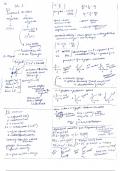
-
Ch 1- Forces and Motion
- Summary • 5 pages • 2024
-
- $4.49
- + learn more
A holistic summary which covers all the aspects of physics igcse chapter of FORCES and MOTION including the subtopics- Scalars, Vectors, Speed , Accelerati on , weight, density, Spring, Centripetal force , Resultants , Parallelogram Law, Moments , Momentum, and it’s applications.

-
Engineering Mechanics: Statics
- Other • 934 pages • 2023
-
- $20.49
- + learn more
An engineering mechanics-statics book is a fundamental textbook that covers the principles of mechanics and their application to engineering problems. It provides a comprehensive introduction to the study of forces and their effects on rigid bodies that are at rest or in constant motion. The book is organized into chapters that focus on key topics such as equilibrium, forces, moments, and free body diagrams. The book includes detailed explanations of topics such as trusses, beams, friction, a...
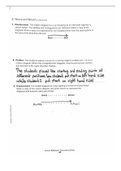
-
Representing Motion: where and when (pt.4)
- Interview • 1 pages • 2023
- Available in package deal
-
- $3.99
- + learn more
In unit 1, Representing Motion, lesson 2, Where and When, students will learn when and how coordinate systems are used. Terms such as velocity, time intervals, displacement, distance, vectors, scalar, magnitude, and resultants are introduced. Terms are defined thoroughly with equations brought to further expand concepts such as displacement.
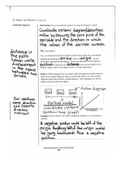
-
Representing Motion: where and when (pt.2)
- Interview • 1 pages • 2023
- Available in package deal
-
- $3.99
- + learn more
In unit 1, Representing Motion, lesson 2, Where and When, students will learn when and how coordinate systems are used. Terms such as velocity, time intervals, displacement, distance, vectors, scalar, magnitude, and resultants are introduced. Terms are defined thoroughly with equations brought to further expand concepts such as displacement.
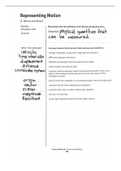
-
Representing Motion: where and when (pt.1)
- Interview • 1 pages • 2023
- Available in package deal
-
- $3.99
- + learn more
In unit 1, Representing Motion, lesson 2, Where and When, students will learn when and how coordinate systems are used. Terms such as velocity, time intervals, displacement, distance, vectors, scalar, magnitude, and resultants are introduced. Terms are defined thoroughly with equations brought to further expand concepts such as displacement.

Study stress? For sellers on Stuvia, these are actually golden times. KA-CHING! Earn from your study resources too and start uploading now. Discover all about earning on Stuvia

